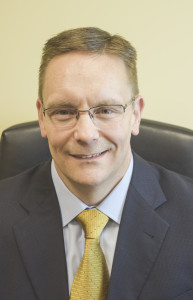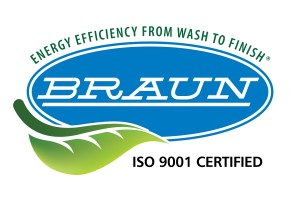
By Joe Gudenburr, President G.A. Braun, Inc.
The goal of any laundry is to process goods quickly and efficiently. However throughput can be affected by several issues. How can you pinpoint these issues and increase the throughput at your laundry?
As with any process, you need to start at the beginning. Too often people concentrate their efforts where a problem manifests – as opposed to considering what upstream variables can be creating the problem. Without looking at the entire process, problems typically spin further out of control and production of goods becomes less efficient.
WASHROOM
On the washroom side, processing areas begin from soil sort and extend to the point where goods depart the dryers or a bypass conveyor, to be transferred to an operation’s finishing area.
There are a number of areas where constraints can be generated within the washroom.
Often the problems originate in the soil room as like materials are not staged properly which causes machines to run under loaded, or possibly with unpaired batches (in a tunnel), or with empty pockets. These situations all cast a negative impact on capacity and the downstream processing areas.
Under-sized loads sent to a dryer do not equate to shorter dry times and more efficient energy consumption. The reality is that smaller loads increase drying times and energy consumption. They also create an out of balance situation in the washroom where washing systems (conventional or tunnel) are now waiting for a dryer to accept washed items.
FORMULA MANAGEMENT
Another problem area could be formula management. On the conventional wash front, the current generation of machines available on the market have a great deal of flexibility with the configuration of their formulas to optimize the wash and extraction process. By leveraging this capability, you can optimize the efficiency of the dryers, or optimize the extraction process so that linens are sent straight to the ironer without conditioning.
On the tunnel side, operators are often fixated on speed. Many think that if they run a 90-second cycle it will result the system processing a higher volume. Nine times out of ten, this is not the case. Why? A press reaches its optimal extraction based on its ability to remove water from the basket, and its ability to rapidly build to its desired pressure.
The best presses on the market typically achieve 40-45 seconds under high pressure in a 90-second formula. However, optimal extraction typically takes place between 60-75 seconds under high pressure. The best presses can achieve this utilizing 2 minute formula time.
It should be noted that there is another misconception with respect to ‘bar’ ratings. A press must be evaluated based on its system pressure and the ability to build pressure at the membrane. Higher numbers don’t always equate to higher actual membrane or system pressures. Additionally, there is a point in the pressing process where materials are compressed creating a barrier layer, and no matter how hard you press you will not remove more water. It is recommended that you let your OEM educate you on your specific machinery and its capabilities.
Many operators say, “I am running 90-seconds and I don’t understand why I am not getting 40 transfers an hour.” When you look at the system you typically find that the volume of dryers was not sized to condition all products, or to support a 40 transfer an hour capacity. The conditioning situation is driven by running too short of a press cycle. When you show the same accounts that they can save energy, improve capacity, and eliminate conditioning by running a more optimal formula, they are hesitant at first. But ultimately, they appreciate the approach once it is shown to perform as advertised.
MATERIAL HANDLING
A third possible problem area to consider in the washroom is material handling. Many plants simply don’t keep up with unloading their dryers or their unload conveyors. This is usually tied to a lack of operational discipline within the facility. In some cases when addressed throughput capabilities can improve by as much as 10 percent. This costs zero!
FINISHING
On the finishing side there are three common problem areas to rule out when looking for ways to improve your laundry’s production capability. The first is ironer line speeds. This can be a result of not having a large enough ironer or enough surface contact under pressure to dry the product. This may be the result of insufficient boiler capacity, or bypass items reaching the ironing line with too high of a moisture content. The latter ties right back to the above discussion on formulas and cycle times.
The second finishing area to be addressed would be material handling. As we all know, there is a great deal of touch labor on the finishing end of most plants. Automation and the elimination of processing or handling nodes in this area can greatly improve overall efficiency. As noted, automation can provide a real benefit but it must be designed into the system if it is not, it can create a bottleneck.
Finally another possible limitation that many plants face is with respect to how their mix of products aligns with the capabilities of their processing equipment. Often there are specific machines that can be called ‘one dimensional.’ Once these machines or processing systems have exhausted the products that they are designed to process, they often sit idle as they can’t handle the other product types that are waiting to be processed.
A way to optimize capacity, energy and labor utilization on the finishing end of the business is to make certain that you employ dynamic solutions that provide a great deal of processing flexibility as volume and mix changes throughout the course of the year.
There are additional areas that you can focus upon as you dissect your specific laundry operation, however, these are the most common bottlenecks in the markets that our industry serves.
About the Author
 Joe Gudenburr is the President of G. A. Braun, Inc. In this role, he has the responsibility for all P&L, operational, sales, and R&D /technology development initiatives that take place within the company. On an annual basis, he visits well over 100 operating facilities around the world (hospital OPL’s, prisons, industrial plants, cruise ships, and large co-op/central processing sites), which affords him the opportunity to see where the industries’ operators are doing an exceptional job and where they have challenges that can be turned into opportunities for improvement. Joe has been an active member of various industry associations since joining Braun, and has been an author for various industry publications and holds multiple patents for technologies developed.
Joe Gudenburr is the President of G. A. Braun, Inc. In this role, he has the responsibility for all P&L, operational, sales, and R&D /technology development initiatives that take place within the company. On an annual basis, he visits well over 100 operating facilities around the world (hospital OPL’s, prisons, industrial plants, cruise ships, and large co-op/central processing sites), which affords him the opportunity to see where the industries’ operators are doing an exceptional job and where they have challenges that can be turned into opportunities for improvement. Joe has been an active member of various industry associations since joining Braun, and has been an author for various industry publications and holds multiple patents for technologies developed.














